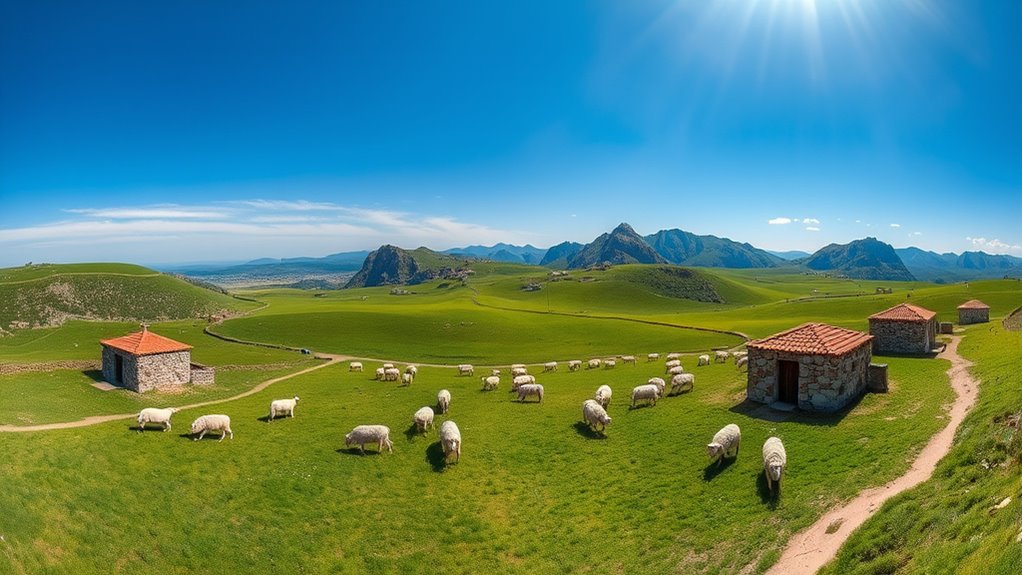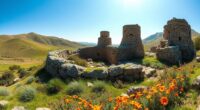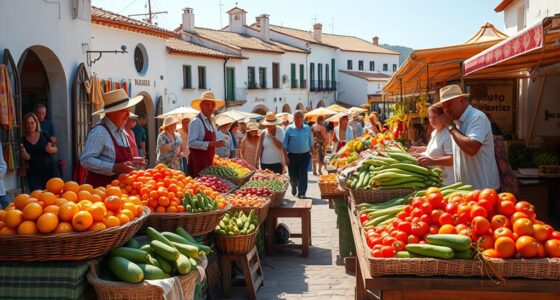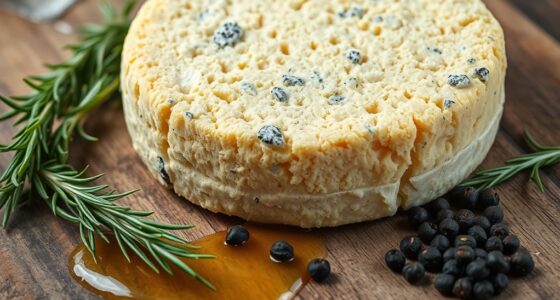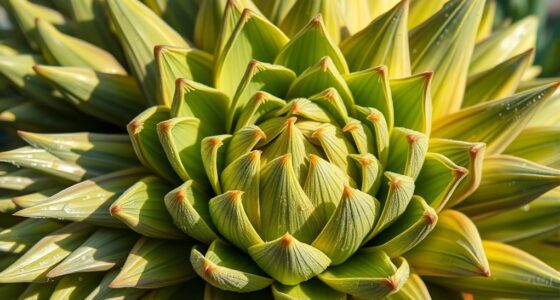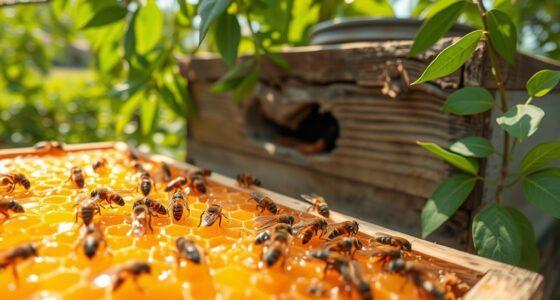Sheep farming in Sardinia is an ancient tradition that plays a essential role in local culture, producing famous cheeses like Pecorino. You’ll find resilient breeds like the Sarda that adapt to tough terrains and sustain families through generations. Despite economic challenges and environmental concerns, efforts to modernize practices and protect the land keep this heritage alive. If you want to explore how this tradition continues to evolve, there’s more to uncover ahead.
Key Takeaways
- Sheep farming in Sardinia dates back to the Bronze Age, deeply rooted in ancient Mediterranean traditions.
- The Sarda breed is vital for high-quality cheese production like Pecorino Sardo and Pecorino Romano.
- Pastoral families practice seasonal transhumance, preserving millennia-old shepherding traditions.
- Land use practices and grazing influence cheese flavors and environmental sustainability.
- Modern innovations and regional initiatives support the sector’s growth while maintaining traditional cultural heritage.
The Rich Heritage of Sardinian Sheep Farming
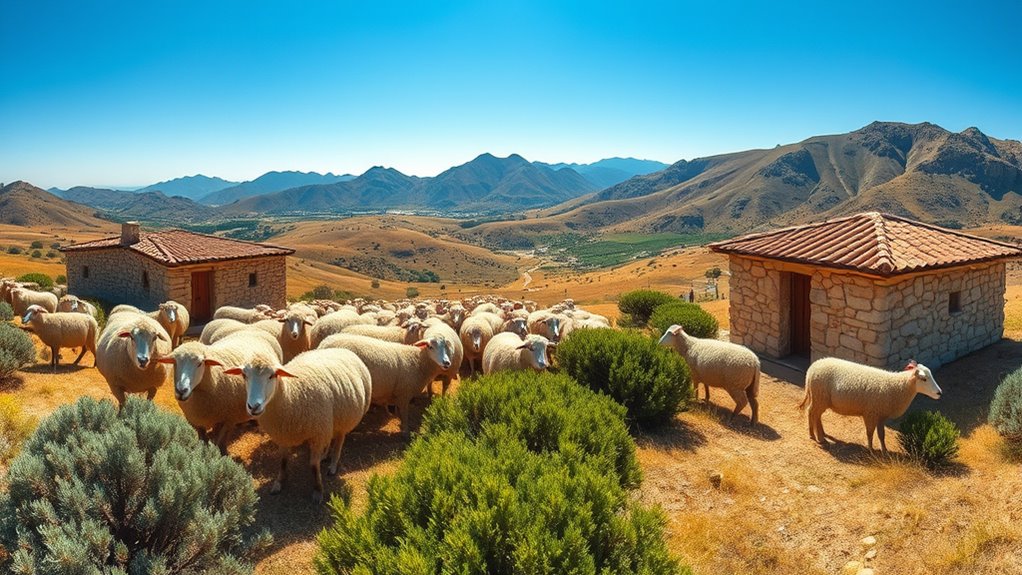
Sheep farming in Sardinia has a history that stretches back thousands of years, making it an essential part of the island’s cultural identity. Since the Bronze Age, during the Nuragic civilization, sheep husbandry provided food and cheese, establishing a deep-rooted tradition. Over centuries, it expanded alongside grain cultivation, with records from the 1700s showing diverse cheese-making based on sheep milk, ancestral to Pecorino. This heritage links current practices to ancient Mediterranean cultures. The landscape influences your sheep’s grazing, as they roam aromatic herbs and meadows, shaping the flavor of Sardinian cheeses. Pastoral families maintain seasonal migrations, blending tradition with modern methods. Sheep farming sustains local communities, supports artisanal cheese production, and preserves a crucial cultural legacy that has thrived for millennia. This longstanding tradition is also reinforced by the unique climate and terrain of Sardinia, which create optimal conditions for sheep grazing and cheese development. Additionally, research into traditional livestock practices highlights their importance in maintaining biodiversity and ecological balance on the island.
The Role of the Sarda Breed in Local Agriculture
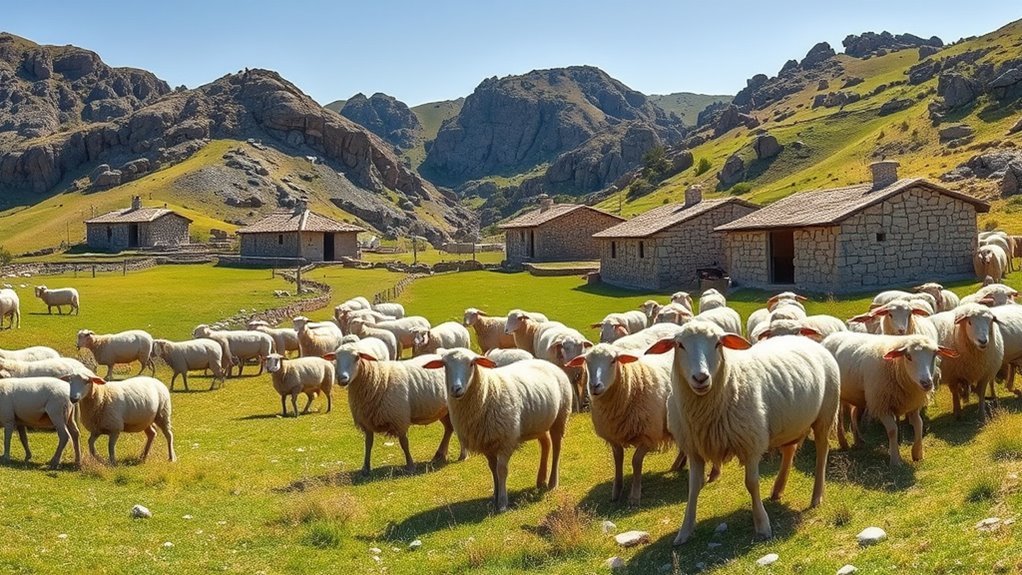
The Sarda breed plays a crucial role in Sardinian agriculture by combining resilience, high milk production, and adaptability to the island’s diverse landscapes. You benefit from their sturdy build, which allows them to thrive in mountainous, lowland, and Mediterranean environments. Their high milk yield—up to 180 kg per lactation—supports the production of traditional cheeses like Pecorino Sardo and Pecorino Romano, both DOP-certified. These sheep also contribute to local meat markets through milk lambs, slaughtered young for quality. Their hardy nature and strong maternal instincts ensure flock sustainability, even in challenging conditions. The breed’s adaptability to transhumance and various grazing systems makes them essential for maintaining Sardinian pastoral practices, reinforcing their integral position in local agriculture and rural livelihoods. Their resilience to harsh climates also enables them to sustain productivity in environments with limited resources, highlighting their importance in sustainable pastoral systems.
Economic Challenges and Market Dynamics

Despite its essential role in Sardinian agriculture, the sheep farming sector faces significant economic and logistical hurdles. You’re part of a sector with over 4,300 companies generating around €53 million annually, critical for local economies like Sassari and Gulf of Asinara. However, high production costs, limited infrastructure, and poor territorial continuity hinder market access and trade. Global crises, such as the pandemic and conflicts, further strain resources. Funding remains scarce, with land credit dropping 40% since 2009, restricting modernization. Sustainable practices Despite these challenges, farmers are adapting through sustainability projects like LIFE GreenSheep and regional initiatives, aiming to enhance competitiveness. Sector Growth and Economic Impact Additionally, the creation of initiatives such as the Sassari and Gulf of Asinara Rural District demonstrates a strategic effort to support local producers and improve market access. Policy support and improved logistics are essential to keep this indispensable sector resilient, innovative, and capable of meeting future market demands.
Land Use and Environmental Impacts
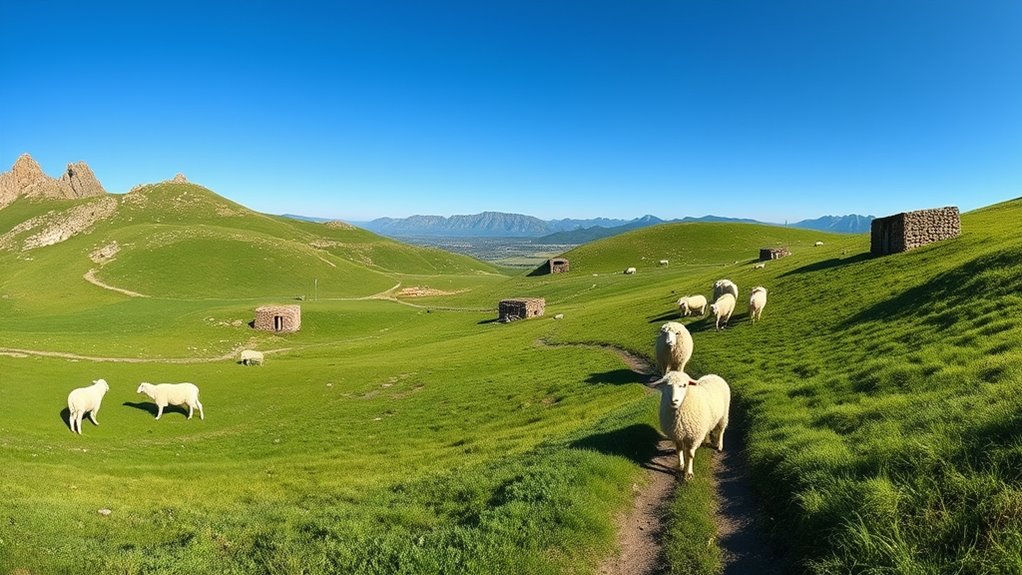
Sardinia’s extensive land use patterns considerably influence both sheep farming practices and the environment. You’ll notice that about 44% of the land is agricultural, with natural grasslands making up 35%. Sheep graze mainly on natural pastures, which are sensitive to overgrazing. To protect the land, consider these key points:
Sardinia’s land use impacts sheep grazing and ecosystem health; overgrazing threatens soil and biodiversity.
- Shallow soils on volcanic rocks are prone to erosion if overgrazed.
- Summer droughts reduce pasture quality, risking overgrazing.
- Limited water resources challenge pasture growth and sheep hydration.
- Conservation efforts, like biodiversity contracts, aim to balance grazing and ecosystem health.
- Regular monitoring of soil health and pasture conditions can help prevent land degradation and sustain productive grazing systems.
Managing pasture use and recovery is crucial to prevent land degradation, preserve soil fertility, and sustain sheep farming’s ecological balance.
Key Products and Production Practices
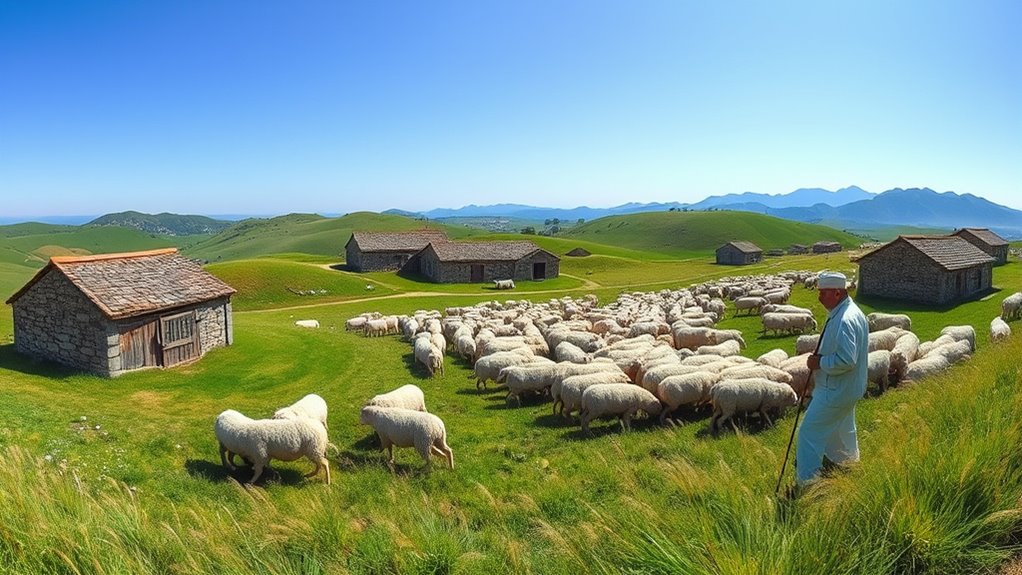
Key products from Sardinian sheep farming include dairy, meat, wool, and artisanal cheeses, each shaped by traditional practices and regional breeds. Dairy accounts for about 60% of regional output, with nearly half used for Pecorino Romano PDO, a sharp, hard cheese. Pecorino Sardo PDO is also popular, available in younger and mature forms. Sheep meat makes up around 20%, mainly from suckling lambs and culled sheep, with 6,472 tons produced in 2010. Wool yields about 1.5 kg per sheep, with Sardinian Merino prized for fine fiber and Longhaired for its curls. Farming relies on extensive grazing on permanent pastures, supplemented by conserved forages. Breeds like Sarda, Merino, and Longhaired specialize in meat, wool, and cheese production. Sustainable grazing practices contribute to environmental resilience and the health of the ecosystem.
Contemporary Issues and Future Perspectives

Sheep farming in Sardinia is experiencing significant growth and transformation driven by economic, environmental, and technological factors. You’ll notice this through key developments: 1. Over 4,300 farms generate about 53 million euros, highlighting its crucial economic role. 2. Turnover in Northern Sardinia doubled from 35 to 70 million euros (2019–2023), despite environmental challenges. 3. Agritourism’s turnover rose 64% since 2019, reaching 4.6 million euros, reflecting rising demand for authentic experiences. 4. Farms are adopting innovative technologies like precision livestock tools and eco-friendly practices to boost productivity and sustainability. Recent studies also emphasize the sector’s potential for eco-innovation, which could further enhance its sustainability. These changes point to a sector balancing tradition with modern innovation, supported by strategic planning and farm consolidation efforts aimed at resilience and future growth. Incorporating modern equipment and sustainable practices is increasingly essential for maintaining competitiveness and addressing environmental concerns in sheep farming.
Frequently Asked Questions
How Do Modern Technologies Influence Traditional Sheep Farming Practices in Sardinia?
Modern technologies markedly impact traditional sheep farming by improving efficiency, animal welfare, and productivity. You can now use sensors and data tracking to monitor sheep health, automate feeding and milking, and optimize reproductive cycles. These tools help you manage your farm more sustainably while preserving key traditions. Embracing innovation allows you to enhance your practices, increase income, and safeguard the longevity of your farming heritage in Sardinia.
What Are the Specific Challenges Faced by Young Farmers Entering the Sheep Industry?
Imagine you’re stepping into a world where modern challenges meet age-old traditions. You face disease threats like bluetongue, with delayed vaccines and virus variants risking your flock. Economic hurdles, from fluctuating prices to high transport costs, strain your budget. Bureaucratic delays and institutional controls complicate management. Plus, labor shortages and depopulation threaten your community’s future, making it tough to sustain the heritage while adapting to contemporary obstacles.
How Does Climate Change Impact Pasture Availability and Sheep Health?
You see, climate change reduces pasture availability through droughts, soil degradation, and altered grazing areas. This stresses your sheep’s health, making them vulnerable to diseases like bluetongue, which has caused significant mortality. Water scarcity and poor pasture quality lead to nutritional issues and increased disease risk. These environmental stresses threaten your flock’s wellbeing, making sustainable practices and disease management more vital than ever to protect your sheep and livelihood.
What Initiatives Are in Place to Promote Sustainable and Eco-Friendly Sheep Farming?
When it comes to promoting sustainable, eco-friendly sheep farming, Sardinia’s initiatives are nothing to sneeze at. You’re encouraged to adopt improved pasture management with self-reseeding Mediterranean species, reducing chemical use and greenhouse gases. Water conservation, organic practices, and renewable energy help lower environmental impact. Plus, knowledge exchange with international researchers supports climate-friendly grazing methods, ensuring your farm stays productive without harming the planet—showing that you can have your cake and eat it too.
How Does Sheep Farming Contribute to Sardinia’S Local Cultural Identity Today?
You see, sheep farming plays a crucial role in shaping Sardinia’s local cultural identity today. It keeps traditional practices like transhumance alive, fostering community bonds through seasonal events, music, and crafts. It also fuels local pride with iconic products like pecorino cheese. By maintaining historic landscapes and supporting local economies, sheep farming connects you to the island’s rich heritage, ensuring these traditions continue to thrive for future generations.
Conclusion
Sheep farming in Sardinia is more than a tradition—it’s a crucial part of your heritage that shapes the land and economy. As you navigate modern challenges, remember that “you reap what you sow.” Embracing sustainable practices and honoring this legacy can secure its future. By staying committed, you help preserve Sardinia’s unique culture and environment, ensuring that the rich legacy of sheep farming continues to thrive for generations to come.
